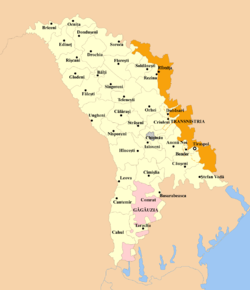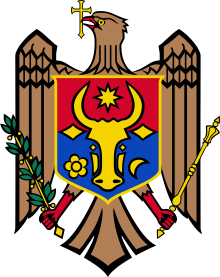Transnistria autonomous territorial unit
Transnistria autonomous territorial unit, officially The Administrative-Territorial Units of the Left Bank of the Dniester (Romanian: Unitățile Administrativ-Teritoriale din stînga Nistrului (Transnistria); Russian: Административно-территориальные единицы левобережья Днестра (Приднестровья); Ukrainian: Автономне територіальне утворення з особливим правовим статусом Придністров'я), is a formal administrative unit of Moldova established by the Government of Moldova to delineate the territory controlled by the unrecognized Pridnestrovian Moldavian Republic.
Transnistria autonomous territorial unit | |
|---|---|
 Location and extent of the Transnistria autonomous territorial unit (brown) within Moldova (white). | |
| Capital | Tiraspol |
| Languages | |
| Legislature | Supreme Council |
| Autonomous territorial unit of Moldova | |
• Created | 27 July 2005[4] |
| Area | |
• Total | 4,163 km2 (1,607 sq mi) |
• Water (%) | 2.35 |
| Population | |
• 2014 estimate | 505,153[5] |
• 2004 census | 555,347 |
• Density | 124.6/km2 (322.7/sq mi) |
| Currency | Transnistrian ruble (PRB) |
| |
History
After the dissolution of the Soviet Union in 1991, the Transnistria War broke out between the Republic of Moldova and the unrecognized state Pridnestrovian Moldavian Republic over territories of the former Moldavian Soviet Socialist Republic. Since the end of the war there has been territory claimed by Moldova, but controlled by the Pridnestrovian Moldavian Republic. There is also territory claimed by the Pridnestrovian Moldavian Republic, which is controlled by Moldova.
On 22 July 2005, the autonomous territorial unit with special legal status Transnistria was established in Moldova.[4]
Territory
The territory of the Autonomous territorial unit Transnistria mostly coincides with territory of Pridnestrovian Moldavian Republic, but there are two important differences:
- Bender is included in Pridnestrovian Moldavian Republic, but is excluded from the Administrative-Territorial Units of the Left Bank of the Dniester.
- Territories which are claimed by Pridnestrovian Moldavian Republic but controlled by Moldova are excluded from Autonomous territorial unit with special legal status Transnistria. These territories include Dubasari District, Causeni District, and Anenii Noi District.
Settlements
There are 147 settlements in Transnistria (settlements on the east bank of the Dniester river): 1 municipality, 9 towns, 2 settlements which are parts of towns, 69 villages (communes), and 135 settlements which are parts of villages (communes).[6]
References
- Roudik, Peter (23 December 2013). "Moldova: Romanian Recognized as the Official Language". Law Library of Congress. Retrieved 13 June 2014.
- "The text of the Declaration of Independence prevails over the text of the Constitution". Constitutional Court of Moldova. 5 December 2013. Retrieved 13 June 2014.
- Law № 173 from 22.07.2005: "About main notes about special legal status of settlements of left bank of Dnestr (Transnistria)" - Article 6: in Moldovan; in Russian.
- Law № 173 from 22.07.2005 "About main notes about special legal status of settlements of left bank of Dnestr (Transnistria)" - Article 3: in Moldovan; in Russian.
- "Moldova". Citypopulation. 1 January 2014. Retrieved 17 April 2014.
- Law № 764 from 27.12.2001 "About administrative-territorial division of Republic of Moldova" - Appendix 5: Moldovan, Russian


